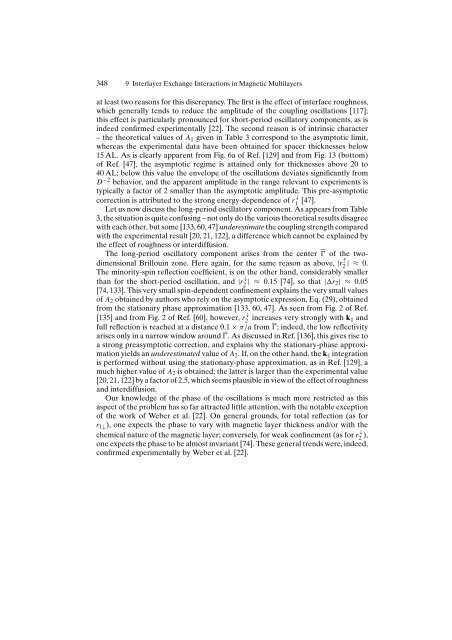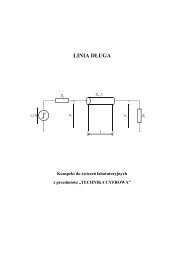9 Interlayer Exchange Interactions in Magnetic Multilayers
9 Interlayer Exchange Interactions in Magnetic Multilayers
9 Interlayer Exchange Interactions in Magnetic Multilayers
Create successful ePaper yourself
Turn your PDF publications into a flip-book with our unique Google optimized e-Paper software.
348 9 <strong>Interlayer</strong> <strong>Exchange</strong> <strong>Interactions</strong> <strong>in</strong> <strong>Magnetic</strong> <strong>Multilayers</strong><br />
at least two reasons for this discrepancy. The first is the effect of <strong>in</strong>terface roughness,<br />
which generally tends to reduce the amplitude of the coupl<strong>in</strong>g oscillations [117];<br />
this effect is particularly pronounced for short-period oscillatory components, as is<br />
<strong>in</strong>deed confirmed experimentally [22]. The second reason is of <strong>in</strong>tr<strong>in</strong>sic character<br />
– the theoretical values of A1 given <strong>in</strong> Table 3 correspond to the asymptotic limit,<br />
whereas the experimental data have been obta<strong>in</strong>ed for spacer thicknesses below<br />
15 AL. As is clearly apparent from Fig. 6a of Ref. [129] and from Fig. 13 (bottom)<br />
of Ref. [47], the asymptotic regime is atta<strong>in</strong>ed only for thicknesses above 20 to<br />
40 AL; below this value the envelope of the oscillations deviates significantly from<br />
D −2 behavior, and the apparent amplitude <strong>in</strong> the range relevant to experiments is<br />
typically a factor of 2 smaller than the asymptotic amplitude. This pre-asymptotic<br />
correction is attributed to the strong energy-dependence of r ↓<br />
1 [47].<br />
Let us now discuss the long-period oscillatory component. As appears from Table<br />
3, the situation is quite confus<strong>in</strong>g – not only do the various theoretical results disagree<br />
with each other, but some [133, 60, 47] underestimate the coupl<strong>in</strong>g strength compared<br />
with the experimental result [20, 21, 122], a difference which cannot be expla<strong>in</strong>ed by<br />
the effect of roughness or <strong>in</strong>terdiffusion.<br />
The long-period oscillatory component arises from the center Ɣ of the two-<br />
dimensional Brillou<strong>in</strong> zone. Here aga<strong>in</strong>, for the same reason as above, |r ↑<br />
2 |≈0.<br />
The m<strong>in</strong>ority-sp<strong>in</strong> reflection coefficient, is on the other hand, considerably smaller<br />
than for the short-period oscillation, and |r ↓<br />
2 | ≈ 0.15 [74], so that |r2| ≈ 0.05<br />
[74, 133]. This very small sp<strong>in</strong>-dependent conf<strong>in</strong>ement expla<strong>in</strong>s the very small values<br />
of A2 obta<strong>in</strong>ed by authors who rely on the asymptotic expression, Eq. (29), obta<strong>in</strong>ed<br />
from the stationary phase approximation [133, 60, 47]. As seen from Fig. 2 of Ref.<br />
[135] and from Fig. 2 of Ref. [60], however, r ↓<br />
2 <strong>in</strong>creases very strongly with k and<br />
full reflection is reached at a distance 0.1 × π/a from Ɣ; <strong>in</strong>deed, the low reflectivity<br />
arises only <strong>in</strong> a narrow w<strong>in</strong>dow around Ɣ. As discussed <strong>in</strong> Ref. [136], this gives rise to<br />
a strong preasymptotic correction, and expla<strong>in</strong>s why the stationary-phase approximation<br />
yields an underestimated value of A2. If, on the other hand, the k <strong>in</strong>tegration<br />
is performed without us<strong>in</strong>g the stationary-phase approximation, as <strong>in</strong> Ref. [129], a<br />
much higher value of A2 is obta<strong>in</strong>ed; the latter is larger than the experimental value<br />
[20, 21, 122] by a factor of 2.5, which seems plausible <strong>in</strong> view of the effect of roughness<br />
and <strong>in</strong>terdiffusion.<br />
Our knowledge of the phase of the oscillations is much more restricted as this<br />
aspect of the problem has so far attracted little attention, with the notable exception<br />
of the work of Weber et al. [22]. On general grounds, for total reflection (as for<br />
r1↓), one expects the phase to vary with magnetic layer thickness and/or with the<br />
chemical nature of the magnetic layer; conversely, for weak conf<strong>in</strong>ement (as for r ↓<br />
2 ),<br />
one expects the phase to be almost <strong>in</strong>variant [74]. These general trends were, <strong>in</strong>deed,<br />
confirmed experimentally by Weber et al. [22].



